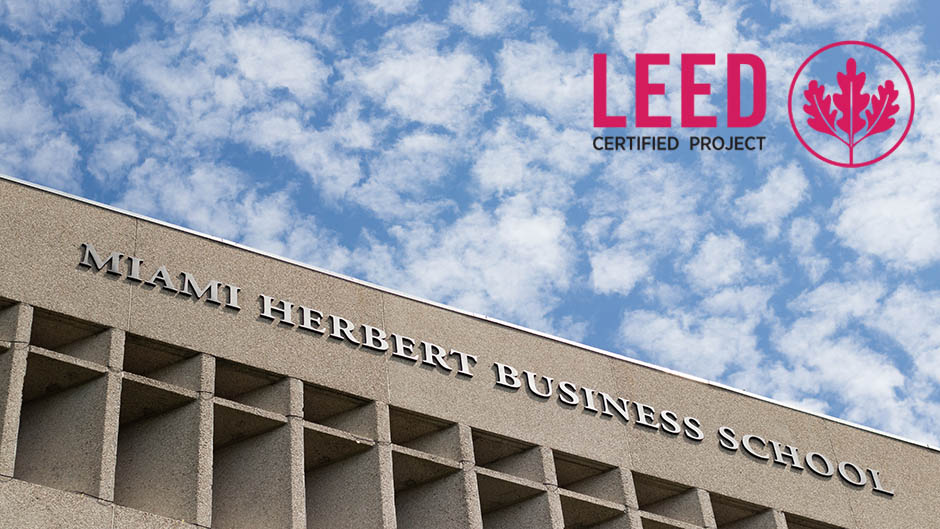The U.S. Green Building Council (USGBC), a preeminent organization assessing sustainable building practices, recently awarded the University of Miami Patti and Allan Herbert Business School building its highest rating for existing buildings: a Leadership in Energy and Environmental Design (LEED) Platinum Certification for Operations and Maintenance (O&M).
“This recognition is an example of Miami Herbert’s commitment to walk the talk in sustainability, innovation, and global impact—it’s weaved into our curricula and in our buildings,” said John Quelch, dean of Miami Herbert. “My hope is that the building’s recognition inspires University of Miami students to learn sustainable business practices they can use in their chosen fields.”
In 2019, the School embraced LEED—the green building certification program that recognizes best-in-class building strategies and practices to reduce energy and create healthier spaces for occupants—and was awarded gold certification. In the same year, the School launched the nation’s first STEM-certified Master of Science in Sustainable Business.
This year’s platinum certification was achieved by implementing practical and measurable strategies and solutions in areas including water savings, energy efficiency, waste reduction, and indoor environmental quality. The LEED rating system is based on earning points under these categories, and Miami Herbert’s building scored 80 out of 110 points.
The building’s continuous sustainability updates and renovations are spearheaded by Blanca Ripoll, executive director of events management, building operations, and special projects, who also led the year-long LEED certification process alongside Spinnaker Group consultants, which guided the school in the first LEED O+M Gold certification in 2019, and the University’s Facilities & Operations Department.
“Knowing that our recertification was approaching, we began tackling LEED requirements months in advance and decided we should apply for platinum certification given our constant and significant green upgrades,” said Ripoll. “And today we can proudly say we are the only LEED O+M Platinum-certified higher education building in Florida, as well as the only LEED O+M Platinum building in the state.”
Additionally, Miami Herbert is one of three higher education projects in the U.S. to achieve LEED O&M certification at the platinum level.
This accomplishment notes significant performance highlights of the 163,885 square-foot facility that has been expanded on since its original 1982 opening date. Notable O+M highlights and accomplishments include:
- Participation in FPL’s SolarTogether program, a community solar program, helped in lowering greenhouse gas emissions by 604 metric tons of CO2e compared to 2019 levels.
- Prioritizing waste reduction efforts. An average of 54% of waste is sent to recycling, recovery, or reuse facilities.
- Reduced total water use by 74,000 gallons compared to 2019 levels. Energy conservation efforts led to reduced cumulative energy use by 1.09M kBtu (kilo-British thermal unit) compared to 2019 levels.
- Above global and local averages for indoor environmental quality, which consisted of indoor air-quality tests conducted throughout all occupied spaces in the building to quantify levels of formaldehyde, carbon monoxide, and other harmful chemicals.
“Miami Herbert’s LEED certification demonstrates tremendous green building leadership,” said Peter Templeton, USGBC president and CEO. “LEED was created to make the world a better place and revolutionize our buildings and communities by providing everyone with access to healthy, green, and high-performing buildings. Miami Herbert is a prime example of how innovative work can create local solutions that contribute to making a global difference.”
This achievement also reflects the University’s commitment to sustainability and the environment, said Jessica Brumley, vice president for facilities operations and planning. Since 2007, the University has actively worked toward carbon neutrality and reducing its greenhouse gas emissions, and it now has more than 17 buildings across three campuses recognized as LEED certified—many of them reaching silver standard and above.

